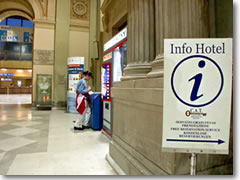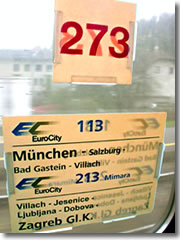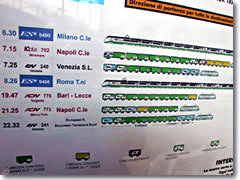- Places
- Plans
- Itineraries
- Experiences
 Italian rail stations are much more than just place to hop a train. They have ATMs, hotel booking services, photo booths, baggage storage lockers, cafes, tourist info offices, newsstands (which, along with newspapers, is also the best place to find city maps, bus/metro tickets, stamps, and a small selection of books in English), restrooms, and in bigger cities often shops and 24-hour pharmacies.
Italian rail stations are much more than just place to hop a train. They have ATMs, hotel booking services, photo booths, baggage storage lockers, cafes, tourist info offices, newsstands (which, along with newspapers, is also the best place to find city maps, bus/metro tickets, stamps, and a small selection of books in English), restrooms, and in bigger cities often shops and 24-hour pharmacies.
Like the trains themselves, Italian train stations tend to be clean and user-friendly—with tourist info, hotel booking service, lockers or offices where you can store your luggage, and snack bars better than you'd expect (in case you forget to pick up train picnic supplies in town).
| Rome | Roma Termini |
| Florence | Firenze Santa Maria Novella |
| Venice | Venezia Santa Lucia |
| Milan | Milano Centrale |
| Genoa | Genova Porta Principe |
| Naples | Napoli Centrale |
| Leghorn | Livorno |
| Turin | Torino Porta Nuova |
The rail information desk—not to be confused with the city tourist board's desk, because the two generally won't answer each other's questions—usually has a long line, and the staff was born harried. Use the do-it-yourself information sources as much as possible.
Modern stations in big cities often have computerized rail information kiosks and automatic ticketing machines, but both can be on the fritz (or feature lines as long as those queuing to talk to a flesh-and-blood ticket agent).
In smaller towns, the tiny station bar may double as the ticket office, but most stations have banks of ticket windows. Try to figure out which window you need before getting in the invariably long lines. The bulk of windows will be for purchasing regular tickets; a few windows will be for people who just need reservations (if, for example, you have a Eurail pass but plan to take a reservations-required train or want to reserve a sleeping couchette). A few windows may be for international or special high-speed trains only.
 I know it's hard to see, but those are two train schedule posters. All of Europe uses this system; on the left are arrivals, on a white poster; on the right are departures on a yellow poster. For a detailed close-up, go to the Italian Rail System page.
I know it's hard to see, but those are two train schedule posters. All of Europe uses this system; on the left are arrivals, on a white poster; on the right are departures on a yellow poster. For a detailed close-up, go to the Italian Rail System page.
Almost all stations have schedule posters that list the full timetables and regular track numbers for all trains that pass through. Usually, but not always, arrivi (arrivals) are on a white poster and partenze (departures) are on a yellow poster, as in the picture to the right. (There's a close-up shot of the "departures" half, along with detailed explanation of how to read the poster, on the Italian Rail System page.)
These posters show how many trains a day go where you want to go, when precisely they leave, whether you need a reservation (marked by a prominent "R" in the column detailing the train's car options—1-2 class or just 2 class, sleepers available, bikes allowed, etc.).
The poster also shows you what the ultimate destination on that train will be. For example, you may want to get from Rome to Pisa, but the train will be marked to Paris; Pisa is merely a stop along the way (and these posters do list all the major stops along the way, including what time the train arrives at each).
 The route cards posted in each train car list the start and end station of the line, along with major stops en route. In some cases, such as in this picture, the car—number 273—is going from Munich all the way to Zagreb, but it will be dong so as part of two different train lines. The train called "EC 113" goes from Munich to Villach, where it will probably join up with (or lose cars to) another train called "EC 213 'Mimara'," which makes the run from Villach to Zagreb. If you want to get to Zagreb and are sitting in this car, it doesn't really matter what the train's technically called before and after the station at Villach; you'll get where you're going anyway.
The route cards posted in each train car list the start and end station of the line, along with major stops en route. In some cases, such as in this picture, the car—number 273—is going from Munich all the way to Zagreb, but it will be dong so as part of two different train lines. The train called "EC 113" goes from Munich to Villach, where it will probably join up with (or lose cars to) another train called "EC 213 'Mimara'," which makes the run from Villach to Zagreb. If you want to get to Zagreb and are sitting in this car, it doesn't really matter what the train's technically called before and after the station at Villach; you'll get where you're going anyway.
Track assignments may change on a daily basis, or even at the last minute (listen to the loudspeaker announcements). In larger stations, check those big electronically updated departure boards—but realize that those, too, can occasionally be wrong. Then seek out a conductor on the indicated platform and blurt out your destination in a questioning voice while pointing at the waiting train for reconfirmation before boarding. Once on board, I also triple-check with passengers who look like they take this train every day.
Each car may very well be splitting off down the line, uncoupled from the rest of the train at some junction station and then joined up to another train headed to an entirely different destination. Yes, this has happened to me before. (Actually, that's a big part of my job: screwing up so you can learn from my mistakes and do it right the first time.)
At any rate, getting on the right car is especially important when you're getting on a night train (if you have a reserved spot, you needn't worry). It's not hard to find the right car, though. Each car has its own destination placard, posted either in the window on the doors (as in the picture on the left), or slipped into a display plaque on the wall of the little entry/exit vestibule where the doors are.
There might be another kind of informative poster once you get to the train track itself (pictured below to the right). It shows you the composition of each train that regularly uses this track, including the locations of its numbered cars. A few seconds' perusal will give you have a sense of (a) where on the platform to wait for the car with your seat reservation, or more importantly (b) where the couchette cars are if you're planning to crash for free.
 These are not as prevalent as they once were, but on many station platforms there are wonderful signs that show you the composition of each train that regularly uses the track.
These are not as prevalent as they once were, but on many station platforms there are wonderful signs that show you the composition of each train that regularly uses the track.
For example, in the poster pictured (hard to reproduce on a tiny computer screen; you'll have to squint and/or just take my word for it here), the second-from-the-top train—the one headed to Napoli—has seven second-class cars (green), followed by a handicapped one (green with a wheelchair), a dining car (red), and then three first-class cars (yellow).
That one's easy. The bottom train to Budapest is more complicated. It's composed of a sleeper car (blue), a second-class couchette car, and four regular second-class cars (the type where you might be able to sleep for free) all going to Budapest (the names of these destinations are written under the train, hard to see in this tiny image, but trust me, they're there). Then there's a second-class car that will end up in Timisoara, followed by two sleeper cars at the end that are going to Bucharest.
This is the sort of vital information that can help you avoid ending up at the wrong end of Eastern Europe, arriving in the capital of Romania when you meant to go to the capital of Hungary.
Again, always check with the conductor and fellow passengers. You may look like an obsessive compulsive dweeb, but at least you won't end up on a train bound for Marseille when you meant to go to Venice.
Share this page
Search ReidsItaly.com